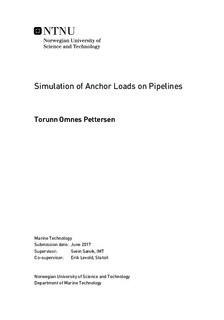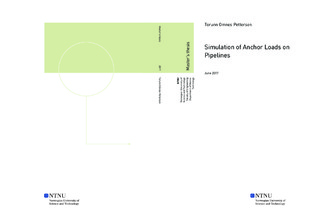| dc.description.abstract | Anchor loads on pipelines are in general a rarely occurring event, but the severity when it happens could easily jeopardize the integrity of any pipeline. The environmental and economic consequences of an accident caused by dragging anchors could be substantial. The offshore pipeline density at several locations in the North Sea is high. High pipeline density combined with high vessel density increase the risk of accidents related to anchor-pipeline interaction.
Currently, there is an ongoing project between DNV GL and Statoil to come out with a new recommended practice for anchor loads on pipelines. The research on anchor-pipeline interaction is quite limited, however some studies on dropped and dragged anchors are conducted. The studies on the subject anchor-pipeline interactions primarily focus on the potential damage an anchor may inflict on a pipeline, the replacement length when accidents happen and risk studies.
One of the observations from the simulations of anchor-pipeline interactions carried out so far is that numerical problems might occur for the contact element CONT164. One of the goals of this work was to establish models for the hooking event using a new contact element developed by Vegard Longva as part of his PhD work at NTNU. Simulations of eleven models were conducted to demonstrate the performance of the new contact element. 55 \% of the models showed unrealistic behavior when the anchor-pipeline interaction was modelled with the old contact element, CONT164. A simulation was classified as unrealistic if the anchor pierced the pipeline, or if the anchor grossly deformed. All models tested showed a realistic behavior when the anchor geometry and contact were modelled with the new contact element.
The objective of this thesis is to study the behavior of the anchor when it collides with an offshore pipeline. A parametric study was performed to investigate the response of the anchor. 250 simulations of anchor-pipeline interactions were performed. The parameters investigated were vessel velocity, pipe diameter, anchor size, span height, damping of the system, sloping seabed, seabed conditions, angle of attack between the anchor and the pipeline and water depth. The pipeline was modelled as a ten-meter-long constrained rigid body in the parametric study. The parametric study indicated that the probability of an anchor hooking onto a pipeline increases with decreasing vessel speed, decreasing pipe diameter and increasing anchor size. The trend is that the hooking ratio increases with increasing anchor mass. However, it is not given that a large anchor hooks onto a pipeline even though a smaller anchor did hook onto the same pipeline. The hooking ratio is highest when the pipeline is partly buried. Increasing the span height decreases the hooking ratio. None of the models hooked the pipeline in the parametric study when the angle of attack between the anchor and the pipeline was 30 or 60 degrees.
24 case studies were performed to investigate how well the anchor s response had been predicted in the parametric study. The pipeline was modelled as ten-kilometers-long and the pipeline was only constrained at the end nodes. In general, the parametric study was good at predicting the response of the anchor-pipeline interaction when the pipeline was not in free span. | |

